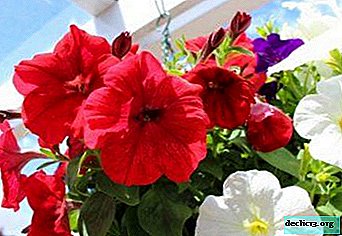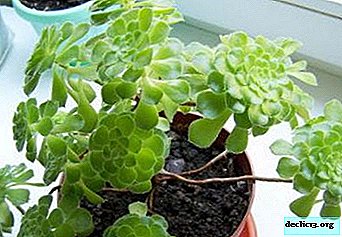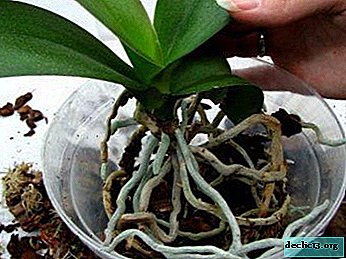What is the difference between ampelic petunia and cascading? Description of varieties, comparative table and photo

Petunia is a perennial plant in the nightshade family. These flowers, originally from South America, serve as decoration of both balconies and loggias, and summer cottages due to the variety of varieties.
Ampel and cascading varieties of petunias are very decorative, they look good in flowerpots, hanging flower pots, decorate terraces and gazebos. These varieties of petunias are very similar, but there are differences between them. And the main difference in the care of them. Let's talk about this in detail in our article.
Description of varieties
Ampelic petunia is a type of plant whose bush is not erect, but forms drooping shoots. There are a lot of flowers on each branch. Ampelic petunia is usually planted in a pot, but sometimes it can grow on a flower bed.: in this case, the shoots spread along the ground, forming a flowering carpet. Strong and elastic shoots of ampelous petunia can grow up to 1.5 meters long, their growth goes from the main stem in the downward direction.
Cascading petunia is essentially a variety of ampelous petunia, shoot length can reach 2 meters, shoots are strong, elastic, their growth comes from the main stem in different directions, including up and to the sides. Such a petunia is also called spreading.
Cascading petunia looks good in arbors, on verandas, on trellises, alpine slides, can serve as a groundcover. In the latter case, petunias need a lot of space for lashes growing in the sides - up to 2 meters.
What is the difference?
| Characteristics | Ampelic Petunia | Cascading petunia |
|---|---|---|
| The length and thickness of the shoots | Up to 1.5 meters thin | Up to 2 meters, thicker, greatly expand |
| Lash growth direction | Way down | Up and to the side, then down |
| Flowers | Small, located along the entire length of the shoot, in the sinuses, the shape is a bell, on one plant can be different colors | Large, on one plant of the same color, grow due to axillary shoots |
| Grow Tank Size | Small | Large, from 5 liters |
| Best place to grow | Hanging planters on the terraces in the gazebos | On a flower bed, in large standing flowerpots, on poles |
Photo
In the photo you can see the ampel and cascading varieties of petunias and understand the difference between them.



Difference in care
In general, there are few differences between the two types of petunia, but they are. And these differences are due to the difference in care.
Pinch seedlings
- In ampelous shoots grow only down from the very beginning, and in order to have more, sprouts of ampelous petunia pinch.
- Cascading shoots can grow in different directions. It is not necessary to pinch the sprouts, it reduces the growth rate and weakens the plant. And without this procedure, there are a lot of buds, and subsequently flowers, the lashes fall down under their weight.
Shoot care
- Cascading petunia shoots are thicker, more powerful, strong, long, give more shoots.
- Ampel shoots are thinner, weaker, they must be handled very carefully so as not to break.
Pruning flowers and seed boxes
ATTENTION: Flowers of cascading petunia are usually larger than ampelous, identical on the same bush. In ampelous, the size and color of the flowers are different on the same plant, in general they are smaller.So that the bush always looks beautiful, ampelous petunia should be cut at least once a week. At the same time, faded inflorescences should be cut off together with seed bolls so that the plant does not waste energy on setting fruits. If this is not done, the petunias enter the fruiting phase, all the forces go to seed set, new flowers are not laid and a complete loss of decorativeness occurs. Read more about caring for ampelous petunia here.
Cascading petunia is not pruned during the entire flowering period.
Placing in flowerpots and watering
 For ampelous varieties of petunias, small hanging pots or flowerpots will be enough. However, it should be remembered that the green mass of this plant is very large, and the root system is limited. Therefore, it is necessary to water ampelous petunia often, in the heat - up to two times a day. You can add hydrogel to the soil - then the moisture will last longer.
For ampelous varieties of petunias, small hanging pots or flowerpots will be enough. However, it should be remembered that the green mass of this plant is very large, and the root system is limited. Therefore, it is necessary to water ampelous petunia often, in the heat - up to two times a day. You can add hydrogel to the soil - then the moisture will last longer.
When watering, you need to make sure that water penetrates both the upper and lower layers of the soil and does not pour out of the cache-pot too quickly. For this, a vase of flowers for a short time is completely placed in a container of water. We examined the nuances of growing ampelous petunia in a cache-pot here.
Cascading petunias are planted in large flowerpots with a volume of at least 5 liters, as well as flower beds, alpine slides, pylons or hedges. They are watered less frequently as the earth dries. Loosening is mandatory, which will provide good air exchange for the roots of petunias.
Top dressing
- Cascading petunia is fed during flowering every 7-10 days complex water-soluble mineral fertilizers with a high content of potassium and phosphorus.
- Ampelic varieties of petunias are fed more often - every 5-7 days, individual varieties even every 2-3 days with complex liquid fertilizer also with a high content of phosphorus and potassium.
Which view is better: selection criteria
Both types of petunias are very beautiful, bright, long-flowering, not too demanding in care. The main selection criterion is the needs of the gardener, depending on the design of the site:
- If you need to decorate the terrace, gazebo, wall of the house, then it is better to choose an ampoule petunia: the flowers will fall from the vase with a multi-colored waterfall.
- If a groundcover is needed, the garden has alpine slides, flower beds with large flowerpots in the center, trellises - a cascading petunia is a good choice: it will encircle trellises or hedges from all sides and form a flowering cascade on the flower bed.
Conclusion
Experienced flower growers combine the types of petunias or alternate them, coming up with a variety of compositions from these beautiful flowers. The main thing is to properly care for the plants, then any of their species will adorn the garden all summer.

















